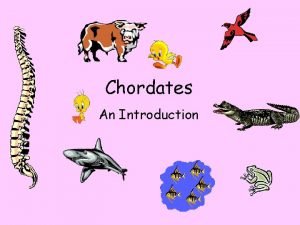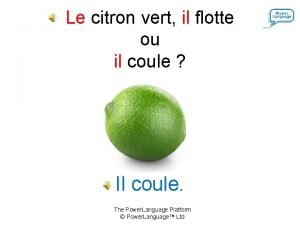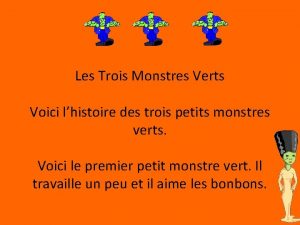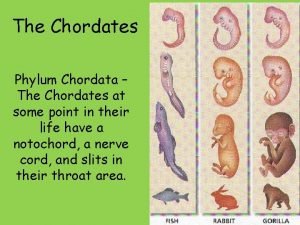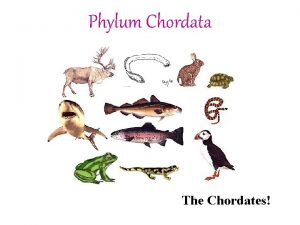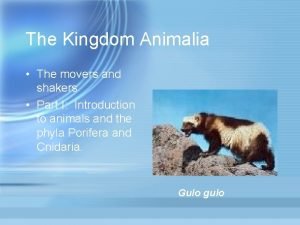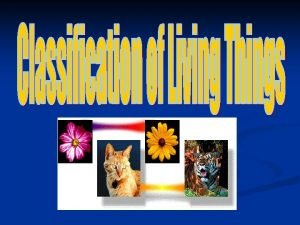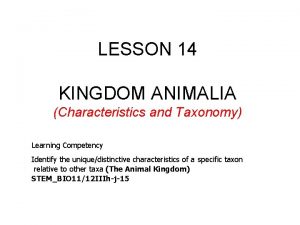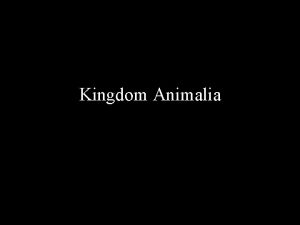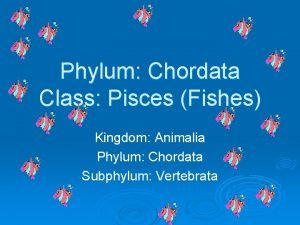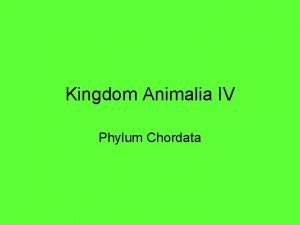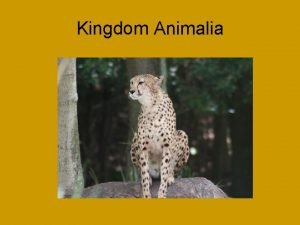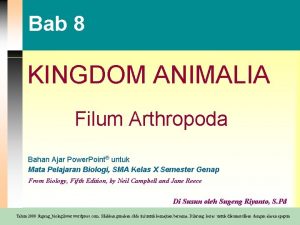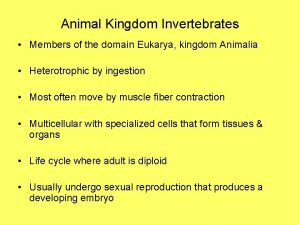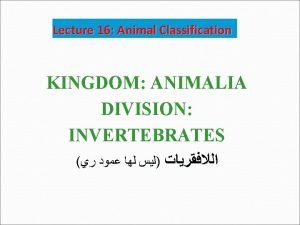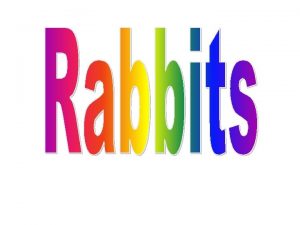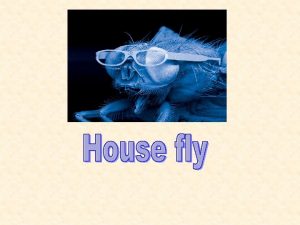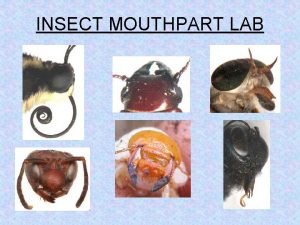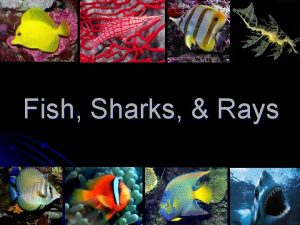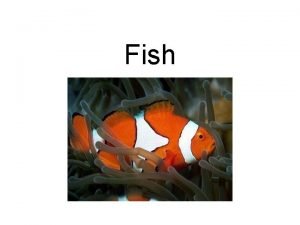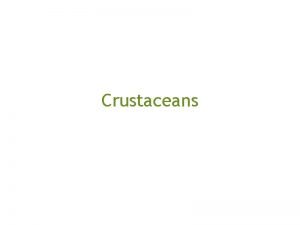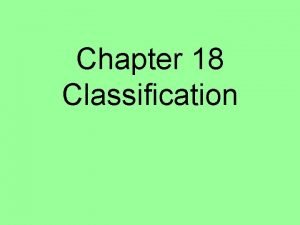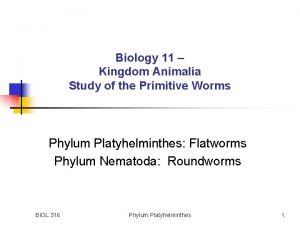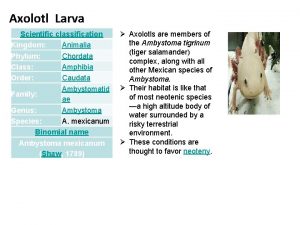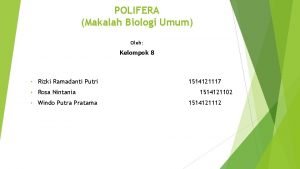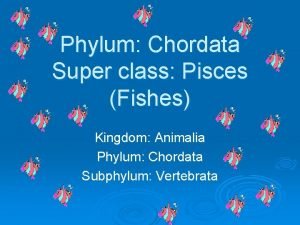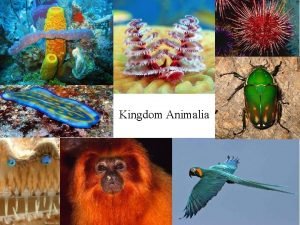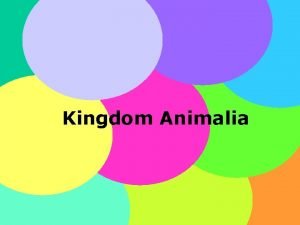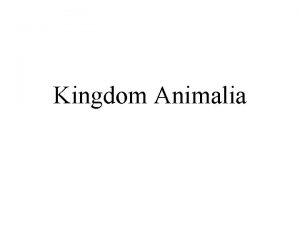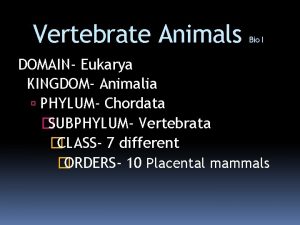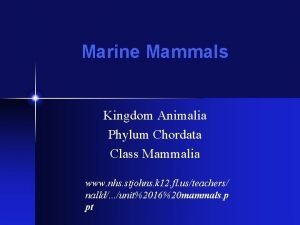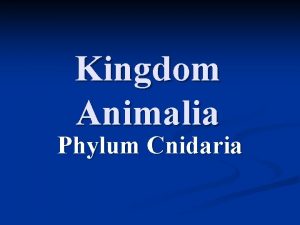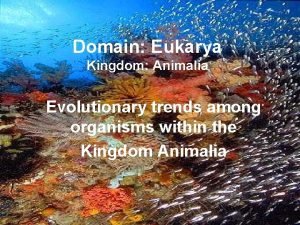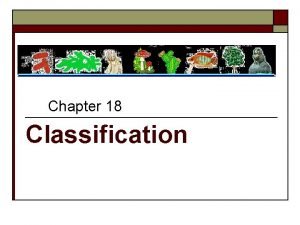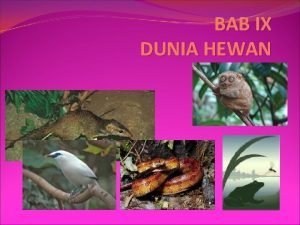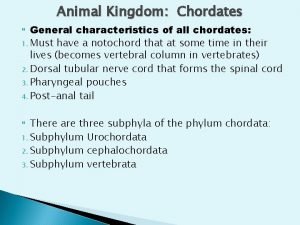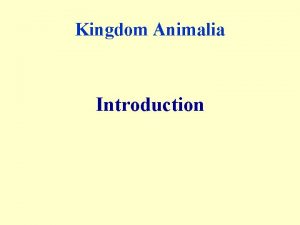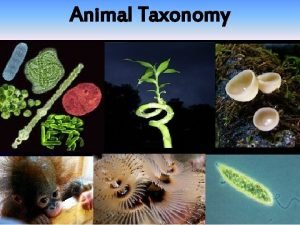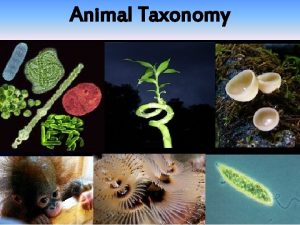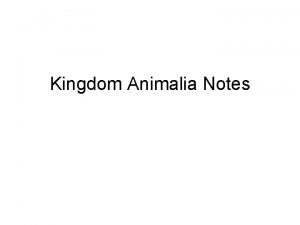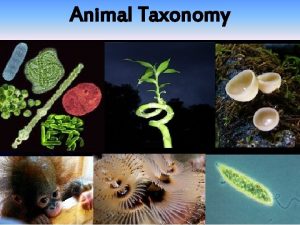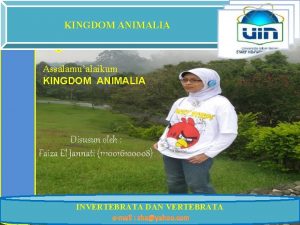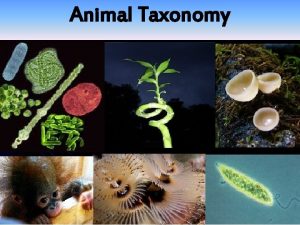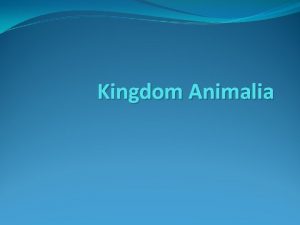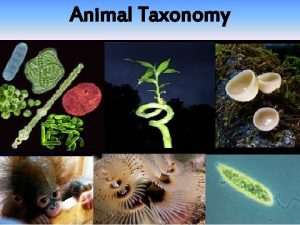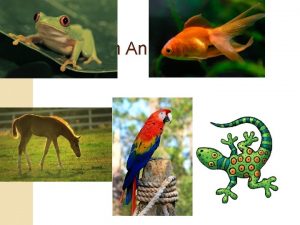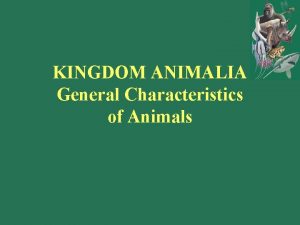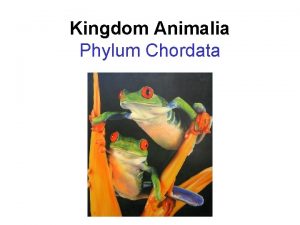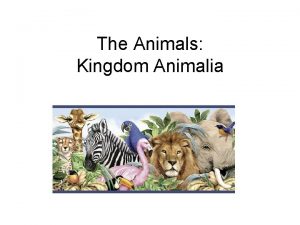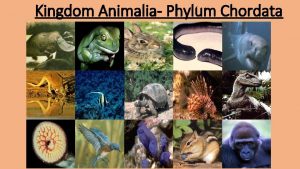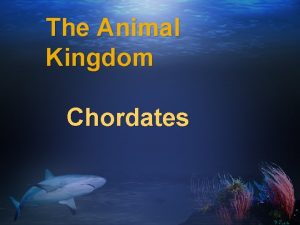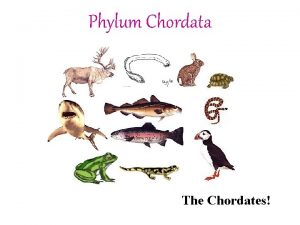Chordates An Introduction Kingdom Animalia All inverts verts


















































- Slides: 50

Chordates An Introduction

Kingdom Animalia- All inverts & verts 1. Phylum Chordata: All have nerve cords. subphyla : A- Urochordata (tunicates aka sea squirts). Only larvae have notochord B-Cephalochordata (lancelets aka Amphioxus). Retain notochord throughout adulthood, but “musclelike” for burrowing C-Vertebrata- Notochord becomes backbone. 7 Classes 3

Section 33 -1 Concept Map Chordates have the following key features Notochord which is A flexible supporting structure Dorsal hollow nerve cord Postanal tail Pharyngeal gill slits/ pouches

Chordates 4

Phylum Chordata 5

Phylum Chordata • Notochord • Gill slits or pharyngeal pouches • Dorsal hollow nerve cord • Postanal tail • Segmented muscles • Deuterostome 6

7

8

9

10

Evolutionary Adaptations of Chordates • From filter feeding ancestors to active predators – – – Mobility Oxygen capture Digestion Circulation Nervous system 11

Skeletal Changes • Skeleton becomes stronger to work with bigger muscles • Allows more rapid movement 12

Oxygen Capture • Gill slit and muscular pharynx will move more water over gills – More oxygen is extracted from water 13

Circulation • Stronger heart to circulate blood faster 14

Digestion • Digest more food – Muscularized gut – Digestive glands • Liver • Pancreas 15

Nervous System • More complex for better – Motor control of body to capture food – Sensory detection of the animals environment – Integration centers (brain) 16

Brain With Three Parts Hindbrain Midbrain Forebrain 17

Section 33 -1 Nonvertebrate chordates Jawless fishes Cartilaginous fishes Bony fishes Amphibians Reptiles Birds Mammals Figure 33– 2 A Cladogram of Chordates

Checkpoint 1. What are the 4 traits that chordates display at some point in their lives? 2. Give 5 examples of Adaptations that allow animals to seek, pursue, and capture prey. 3. Are all vertebrates also chordates? 4. Are all chordates also vertebrates?

Chordate Cladogram Birds Amphibians Fishes Nonvertebrate chordates Invertebrate ancestor Reptiles Mammals

Figure 33– 4 Diversity of Chordates Section 33 -1 Nonvertebrate chordates (4%) Mammals (8%) Birds (18%) Reptiles (14%) Amphibians (9%) Fishes (47%)

Chordate Subphyla Chordata Phylum. Subphylum. Urochordata Subphylum. Cephalochordata Subphylum. Vertebrata 22

Sea Squirts 23

Subphylum Urochordata • Sea squirts (aka tunicate) • Gill slits (pharyngeal slits) • Notochord – Only in larva • Adult has tunic- made of cellulose, sessile • http: //www. arkive. org/starascidian/botryllus-schlosseri/ • http: //finstofeet. wordpress. c om/2010/03/14/1 -2 -beholdthe-tunicates/ 24

25

26

27

https: //www. youtube. com/wat ch? v=n 8 ARUKWPJAE

Subphylum Cephalochordata • Amphioxus (lancelets) • Notochord length of body • Dorsal hollow nerve cord • Gill slits • Segmented muscles • Maintain all chordate characteristics as adult 29

Amphioxus https: //www. youtube. com/wat ch? v=GPn. PXsancl. Y 30

Amphioxus 31


Subphylum Vertebrata: All Vertebrates have: • • • Endoskeleton- backbone Closed circulatory system Bilateral symmetry True coelom Sexual reproduction- internal or external Vertebrate Groups- Fish, Amphibians, Reptiles, Birds, and Mammals

Homeostasis • Endothermic (warm-blooded)- internal temp. regulation that must be maintained Ex. Birds & Mammals • Ectothermic (cold-blooded)- external temp. regulation/ regulated by environment Ex. Nonvertebrate chordates, Fish, Amphibians, Reptiles

Temperature Control in Chordates Body Temperature (°C) Section 33 -2 Environmental Temperature (°C) 98. 6 F- avg human temp

How vertebrates maintain their temperature Animal Group Endo/ectotherm Behavior/structure Fish Ectotherm Swim bladder: Cold/move up Hot/move down Amphibian Ectotherm Cool/go in sun Hot/go to water Reptile Ectotherm Cool/bask Hot/go to water Birds Endotherm Cool/fluff feather Hot/raise wings Mammals Endotherm Sweat, pant, shiver

Kingdom Animalia Phylum Chordata Subphylum Vertebrata Class Agnatha “Jawless” Fish (most primitive): Traits: -Sucker like mouth(no jaws) -No fins or paired appendages -Cartilage skeleton w/ notochord Ex: lamprey & hagfish

Kingdom Animalia Phylum Chordata Subphylum Vertebrata Class Chondrichthyes-Cartilage Fish

Class: Chondricthyes Traits: • Cartilage skeleton; 2 chambered heart • Lateral line system –detect vibrations (movement & sense) • Electroreception- ampullae of Lorenzini • Paired appendages- pectoral and pelvic girdles • Poor eyesight, great olfactory • Carnivorous or scavenger, no swim bladder • Ex: sharks, skates, rays



http: //missbakersbiologyclass. com/blog/2009/ 04/06/dogfish-shark-dissection-includesvideo/

http: //www. youtube. com/watch? v=NTM 0 K 6 t. EIo A dead shark live babies

Fish Scales

Tails Sharks and rays lungfish Bony fish

Fish Tail Cladogram

Kingdom Animalia Phylum Chordata Class Osteichthyes. Bony Fish Traits: Bony skeleton; 2 chambered heart Lateral line system/movement & sense Swim bladder-control depth (buoyancy) Have operculum over gills Good smell (olfactory) and eyesight Ex: perch, bass, flounder



http: //www. youtube. com/watch? v=p. NZQEm. Gp 11 k
 Animalia kingdom chordates and vertebrates
Animalia kingdom chordates and vertebrates Il coule
Il coule Monstres verts
Monstres verts Old kingdom middle kingdom new kingdom
Old kingdom middle kingdom new kingdom Nnn ruled
Nnn ruled Old kingdom middle kingdom new kingdom
Old kingdom middle kingdom new kingdom Mentohotep
Mentohotep 4 key characteristics of chordates
4 key characteristics of chordates Chordata images
Chordata images Nine phyla of kingdom animalia
Nine phyla of kingdom animalia Kingdom animalia cell structure
Kingdom animalia cell structure Animalia characteristics
Animalia characteristics 6 kingdoms cladogram
6 kingdoms cladogram Characteristics of animalia
Characteristics of animalia Cartilaginous fish class
Cartilaginous fish class Monera protista fungi plantae animalia
Monera protista fungi plantae animalia What are chordata
What are chordata Animalia characteristics
Animalia characteristics Arthropoda
Arthropoda Which are all members of the domain eukarya
Which are all members of the domain eukarya Kingdom protista prokaryotic or eukaryotic
Kingdom protista prokaryotic or eukaryotic Division of kingdom animalia
Division of kingdom animalia Family leporidae kingdom
Family leporidae kingdom Kingdom: animalia phylum: arthropoda class: insecta
Kingdom: animalia phylum: arthropoda class: insecta Domain of animalia
Domain of animalia Are insects in the animalia kingdom
Are insects in the animalia kingdom Animalia kingdom
Animalia kingdom Sharks phylum
Sharks phylum Clownfish class
Clownfish class Kingdom animalia phylum arthropoda
Kingdom animalia phylum arthropoda Kingdom animalia contains 350 000 species of what
Kingdom animalia contains 350 000 species of what Characteristics of platyhelminthes
Characteristics of platyhelminthes What are axolotls classified as
What are axolotls classified as Cladogram of animal kingdom
Cladogram of animal kingdom Makalah kingdom animalia
Makalah kingdom animalia Ctenophora vs cnidaria
Ctenophora vs cnidaria Pisces kingdom
Pisces kingdom Monogenea class
Monogenea class Asimetris
Asimetris Animalia kingdom characteristics
Animalia kingdom characteristics All vertebrate animals are in domain
All vertebrate animals are in domain Kingdom animalia phylum chordata
Kingdom animalia phylum chordata Cnidaria characteristics
Cnidaria characteristics Evolutionary trends in animal kingdom
Evolutionary trends in animal kingdom What are the rules for writing scientific names
What are the rules for writing scientific names Anatomi porifera
Anatomi porifera Name a point that is collinear with the given points
Name a point that is collinear with the given points Protista mobility
Protista mobility Plantae kingdom drawing
Plantae kingdom drawing Domain eukarya kingdom fungi
Domain eukarya kingdom fungi The odds and ends kingdom
The odds and ends kingdom
